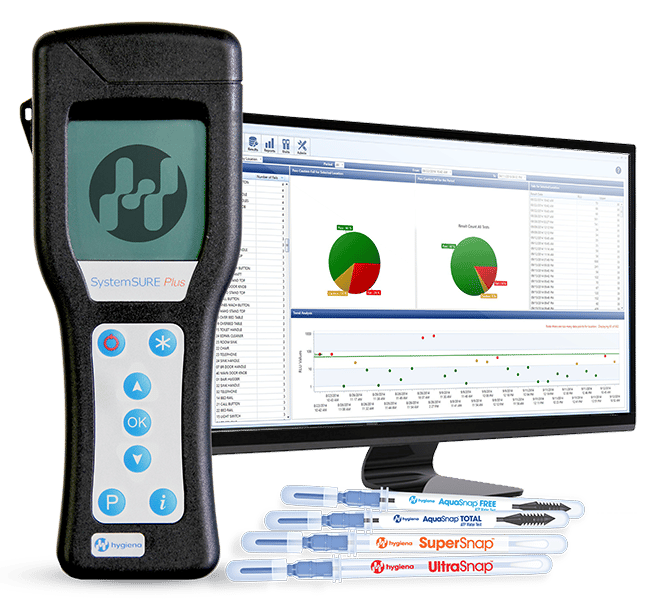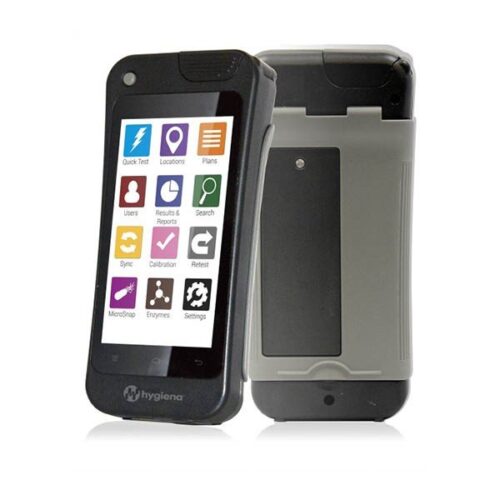ATP Hygiene Monitoring is a vital part of the cleaning process and has a home in a variety of industries.
Discover why ATP Testing is an essential cleaning step that should be followed in your workplace.
What is ATP?
Adenosine Triphosphate (ATP) is an organic compound and hydrotrope that is the principal molecule for storing and transferring energy in cells. ATP provides the necessary energy to drive many processes in living cells, including muscle contraction, condensate dissolution, nerve impulse propagation and chemical synthesis. It can be found in every living thing, and all forms of organic matter contain ATP.
From the perspective of biochemistry, ATP is classified as a nucleoside triphosphate, indicating that it is made up of three components: a nitrogenous base (adenine), the sugar ribose, and the triphosphate

What is an ATP test?
ATP testing or monitoring is a rapid test method used in a range of industries to quickly assess the cleanliness of surfaces or liquids after the cleaning process has taken place. An ATP test is used to measure ATP levels on a surface, and thus the facility’s cleanliness levels. The ATP test provides accurate results that define, monitor & maintain cleaning standards within a facility.
The presence of ATP on a surface indicates improper cleaning and the presence of contamination, including food residue, allergens and/or bacteria. This implies a potential for the surface to harbour and support bacterial growth.
ATP testing in industries
ATP testing has a home in a variety of industries, including Food and Beverage, Food Services, Healthcare, Hospitality, Water Quality, Veterinary & Pet Care, Personal Care & Cosmetics and Industrial & Environmental.
ATP monitoring is used in Food and Beverage facilities to confirm that the presence of ATP has been eliminated or minimised by effective cleaning and sanitation procedures. By carrying out ATP Monitoring, it allows facilities to measure cross-contamination. The results then ensure the integrity of the product, the shelf life and ultimately protects the reputation of the brand.
ATP is present in all organic matter, and therefore all foods contain ATP at varying levels. This is why testing for the presence of ATP is the preferred way to measure the cleanliness of surfaces and water samples.
There is little to no ATP presence in highly processed foods.
Why use Hygiena’s ATP testing swabs and devices?
Our partner Hygiena is an industry-leading provider of ATP Hygiene Monitoring systems and tests. Hygiena utilises advanced technologies and designs to deliver rapid microbial detection, monitoring and identification solutions. These solutions are distributed to a variety of industries. In addition, Sychem and Hygiena have worked in partnership since 2004 to provide ATP testing technology with revolutionary capabilities.
Hygiena’s luminometers, when working with ATP swabs, use bioluminescence to detect residual ATP as an indicator of surface cleanliness. The presence of ATP on a surface indicates that cleaning was undertaken improperly, and there is a contaminated presence, which may include food residue, allergens and/or bacteria. Therefore, there is a potential for the surface to harbour & support bacterial growth.
Hygiena’s advanced ATP testing devices contain a natural enzyme found in fireflies. This enzyme then produces a simple bioluminescent reaction when it encounters any lingering ATP. Hygiena’s SystemSURE Plus and EnSURE Touch ATP luminometers use bioluminescent technology to detect and measure extremely low levels of ATP, collected with testing devices.
Measuring the amount of bioluminescence from an ATP reaction provides an excellent indication of surface cleanliness, because the quantity of light generated by the reaction is directly proportional to the amount of ATP present in the sample.
The reaction from the bioluminescence is immediate so that results can be processed directly at the test site within seconds. The results are expressed as a numerical value on the luminometer scree bub Relative Light Units (RLU).
The bioluminescence reaction is immediate, so results can be processed at the testing site in seconds. Results are expressed numerically on the luminometer screen in Relative Light Units (RLU).

Hygiena EnSURE™ Touch
Next-generation touch screen quality monitoring system
£1,532.00
The EnSURE Touch is an advanced monitoring system that collects, analyses and reports data from various trusted quality test devices. Results in 10 seconds. Providing rapid and accurate sanitation verification data. The system features an intuitive smartphone design for a user-friendly system, and Enzyme test devices for multiple food safety and quality tests. This system is mostly used in the food & beverage and hospitality industries.
Shop NowWhen and where to test for ATP?
The best time to carry out an ATP test is after the initial clean, but before sanitising the surface. This is because sanitiser does not work on a dirty surface, and if the result proves to be a failure, it will be a waste of sanitiser.
One common misconception of the ATP monitoring process is that pre and post-cleaning measurements must be taken to measure the cleaning process. This, however, is not the case. Users must not swab a visibly dirty surface. Collecting samples from visibly contaminated surfaces could inhibit the reaction from the ATP test, and the result will always be a failed test.
Some sanitation companies and chemical suppliers may use pre-clean and post-clean ATP tests to demonstrate the effectiveness of cleaning products, but this demonstration should not be confused with regular use in an ATP monitoring program.
Our ATP Hygiene Monitoring systems
Here at Sychem, we work in direct partnership with Hygiena to provide a range of industry-leading ATP tests and devices. All of our products are available on our Sychem shop.
If you have any questions about our ATP range, get in contact with a member of our expert team today [email protected] or visit the Hygiena website for more information regarding their full range of products.








